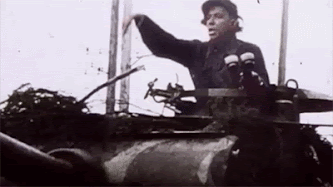Facing the overwhelming military might and the complete air superiority of the Allies, Nazi dictator Adolf Hitler once again relied on his trusted and powerful Waffen-SS divisions to defeat the Allied armies, first in the brutal fighting in
Normandy, and then in the dense forests of the
Ardennes. During these decisive battles, the soldiers of the Waffen-SS repeatedly demonstrated their elite esprit de corps and aggressive fighting spirit, but in the end were unable to win the victories the Third Reich desired. Clear skies on December 24 1944 prevented a catastrophic defeat for the Allies in the Battle of the Bulge. The subsequent aerial barrage wreaked havoc on the German advance when the U.S. 8th Air Force launched the largest air armada in the history of warfare. Top image: B-17 Flying Fortress of the U.S. Army Air Forces in 1944. Credit: Nathan Howland. USAFHRA. Top clip: a Panther tank commander of SS-Obersturmbannführer
Joachim Peiper's Kampfgruppe signals to American POW’s to clear out of the road when fog and low cloud still negated the Allies' air supremacy in the Ardennes in mid-December 1944. Bottom clips:
SS-Kampfgruppe Peiper was also boosted by the Riga-born SS-Obersturmbannführer Heinz von Westernhagen's King Tiger tanks of the schwere SS-Panzer-Abteilung 501 for its drive westwards in the attempt to reach the Meuse River. In the early morning of December 16 1944, the legendary King Tigers of SS 501st heavy tank battalion were filmed passing through the village of Tondorf on their way to Peiper for the initial attack through the Ardennes.
Königstiger n°222 was commanded by SS-Oberscharführer Kurt Sowa. It was knocked out on December 19 1944 at the southern end of the Amblève bridge at Stavelot. Colonel Tom Raney of the U.S. 823rd Tank Destroyer Battalion later wrote:
We saw the long tube of Tiger 222's 88mm gun emerge from behind the last building. The M10 gunner must have been tracking the tank with his telescope sight, for as soon as the Tiger had cleared the building, the M-10 fired one round of armor piercing shot which penetrated the armor on the right side above the track, about 14 inches under the turret and some four to five feet to the rear of the front glacis plate. The tank stopped dead in its tracks. The round probably struck the gunner and the loader. Surprisingly the tank did not burn. Neither did we see any of the crewmembers bail out, but they must have exited through an escape hatch in the rear of the turret. To the best of my knowledge, that was the last enemy tank that attempted to cross the bridge at Stavelot. Tank commander SS-Oberscharführer Kurt Sowa is reported to have lost his right arm below the elbow in action near Sassy in Normandy on August 15 1944, but had nevertheless continued to command during the Bulge. Sowa survived the war and is said to have died in the Ruhrgebiet in the 1970s. Königstiger n°008 was commanded by the battalion adjutant, SS-Untersturmführer Eduard Kalinowsky. It would have the dubious accolade of being the last operational panzer still on the northern bank of the Amblève between Stavelot and Trois-Ponts. Although the tank carried on fighting, it had been immobilised and its crew set it on fire along Route N23 west of Stavelot on Christmas day 1944. Clips: U.S. National Archives and Records Administration.




The optics were great and the king tiger even had night vision! Something revolutionary in its time. They also made use of the world's first anti-reflection coating on the lenses. In Bastogne first days of battle the tiger could see american armor thru the fog. Tanks went up one right after the other while the Americans couldn't see the enemy tanks in the fog.
ReplyDeleteThis comment has been removed by a blog administrator.
ReplyDelete"The Germans are colder and hungrier than we are, but they fight better. I can never get over the stupidity of our green troops." General Patton during the Bulge :)
ReplyDelete